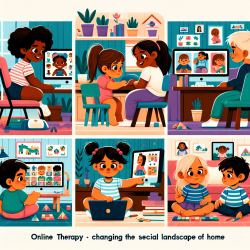Understanding 22q11.2 Deletion Syndrome: A Pathway to Enhanced Therapeutic Outcomes
As a speech-language pathologist, the pursuit of knowledge is continuous, and staying informed about the latest research is crucial for delivering effective therapy. One such groundbreaking study, "Estimates of the Prevalence of Speech and Motor Speech Disorders in Youth With 22q11.2 Deletion Syndrome," offers insights that can significantly impact your practice, especially when working with children diagnosed with 22q11.2 deletion syndrome.
Unpacking the Research
The study provides the first estimates of the prevalence of motor speech disorders (MSDs) in youth with 22q11.2 deletion syndrome, a condition also known as velocardiofacial syndrome or DiGeorge syndrome. This syndrome is characterized by a range of symptoms, including speech-language delays and velopharyngeal dysfunction. The research involved 17 children and adolescents, revealing that a staggering 82.4% met criteria for one of four MSDs. These include:
- Speech Motor Delay (29.4%)
- Childhood Dysarthria (29.4%)
- Childhood Apraxia of Speech (11.8%)
- Concurrent Childhood Dysarthria and Childhood Apraxia of Speech (11.8%)
Such findings underscore the importance of recognizing MSDs as a core phenotypic feature of 22q11.2 deletion syndrome.
Implications for Practitioners
Understanding the prevalence and nature of these disorders in children with 22q11.2 deletion syndrome can guide practitioners in tailoring their therapeutic approaches. Here are some actionable insights:
- Early Identification: Be vigilant in identifying signs of MSDs early in children with 22q11.2, as early intervention can lead to better outcomes.
- Customized Therapy Plans: Develop individualized therapy plans that address the specific type of MSD, whether it be motor delay, dysarthria, or apraxia.
- Cross-Disciplinary Collaboration: Collaborate with other healthcare professionals to address the multifaceted needs of children with 22q11.2, including potential cognitive and developmental challenges.
- Continuous Monitoring: Regularly assess the progress of speech therapy interventions and adjust strategies as needed to ensure they are meeting the child's evolving needs.
Encouraging Further Research
While this study provides valuable insights, it also highlights the need for further research. Larger sample sizes and diverse populations can help validate these findings and refine therapeutic approaches. As practitioners, staying engaged with ongoing research and contributing to the field through data collection and sharing experiences can enhance our collective understanding and improve outcomes for children with 22q11.2 deletion syndrome.
For those interested in delving deeper into this research, you can access the full study by following this link: Estimates of the Prevalence of Speech and Motor Speech Disorders in Youth With 22q11.2 Deletion Syndrome.
By integrating the findings from this study into your practice, you can make informed, data-driven decisions that enhance the quality of care for children with 22q11.2 deletion syndrome. Together, let's continue to strive for excellence in speech-language pathology and make a lasting impact on the lives of the children we serve.










